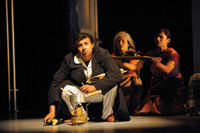From maths to monsoons, Judith Dimant reveals how Complicite made it to Mumbai – despite two false starts

There is no infrastructure in India for performing international theatre on the scale of ‘A Disappearing Number’ – we are 28 people on the road, with the technical gear of a major rock band. But to bring the story of Ramanujan, one of the greatest mathematicians of the twentieth century, to audiences in India became an obsession for Complicite. Tenacity, belief, negotiation, commitment – it tested every one of my skills as a producer.
It was back in 2005, when we were presented ‘Measure for Measure’ (a production originally created for the Olivier stage at the National Theatre) in India, that there was much talk of the story of Srinivasa Ramanujan – the Indian mathematician at the heart of our play ‘A Disappearing Number’. People we met offered opinions on what to read, where to visit, whom to talk to – how to learn more about this mathematical genius. Artistic Director Simon McBurney was hooked. A research trip was planned, followed by exploratory workshops and the play was finally on stage in Plymouth in 2007.
INDIAN DREAMS
Our journey with India had actually begun in about 1998 when I was contacted by Sanjna Kapoor, a theatre owner from Bombay. Her grandfather was Geoffrey Kendal, father of Jennifer and Felicity Kendal. Jennifer was Kapoor’s mother and it had been her vision, alongside her famous film star husband Shashi Kapoor, to create a theatre in Bombay. Jennifer died of cancer in the 1980s and Kapoor carried on her mother’s dream to see the completion and opening of the Prithvi Theatre.
It was with Kapoor that Complicite finally made it to Mumbai this summer. Our commitment to seeing this piece in front of Indian audiences took over our lives and I’m sure that if it hadn’t we would never have got there. In 2008 we nearly made it – the British Council agreed to give us some modest financial support and Kapoor had found a major sponsor at her end. Of course, then the world economy crashed and the sponsor disappeared. It wasn’t to be. Kapoor asked us to try again in 2009, but we weren’t touring the show. And then through Professor Marcus du Sautoy (the renowned Oxford mathematician), we were contacted by the International Congress of Mathematicians and invited to play at the 2010 congress in Hyderabad. Everything was against us. There was no money in Hyderabad. There was no theatre in Hyderabad! We played in a barely built auditorium miles from the centre of the city. It was the monsoon season. Mathematicians don’t present plays.
THIRD TIME LUCKY
But at last, in August 2010 the production made it to India proper. It was our third attempt. I had remained in close contact with Kapoor, and we spoke often on how we could bring the piece to India. We faltered many times along the way and almost gave up as some source of income or other didn’t materialise. We just kept on begging, calling, writing. There was no strategy at all behind our fundraising. We just tried everything we could. Between us, we cajoled the British Council into giving us proper financial support that made the trip possible. In India, Kapoor raised sponsorship from numerous big companies (Citibank, Tata Photon). In London I wrote letters and filled in application forms and raised just under £100,000. Someone saw our campaign on the Complicite website and came forward with half of that amount.
Kapoor presented us in Mumbai this summer. The shows sold out. Ramanujan’s nephew came along with hundreds of others. This time the British Council supported us in a substantial way. It was very involved, financially and practically. It arranged talks and workshops in Hyderabad, Mumbai and Kolkata. We also ran a week-long maths and drama workshop for primary schoolchildren organised by the Prithvi in Mumbai – led by two Complicite teachers/actors.
Making it to India was possibly the hardest thing we had ever pulled off, but one of the most rewarding experiences of my time at Complicite. The story of how we finally made it to Mumbai, with the false starts, is by no means a conventional one, but it has been unforgettable in every way.
Join the Discussion
You must be logged in to post a comment.